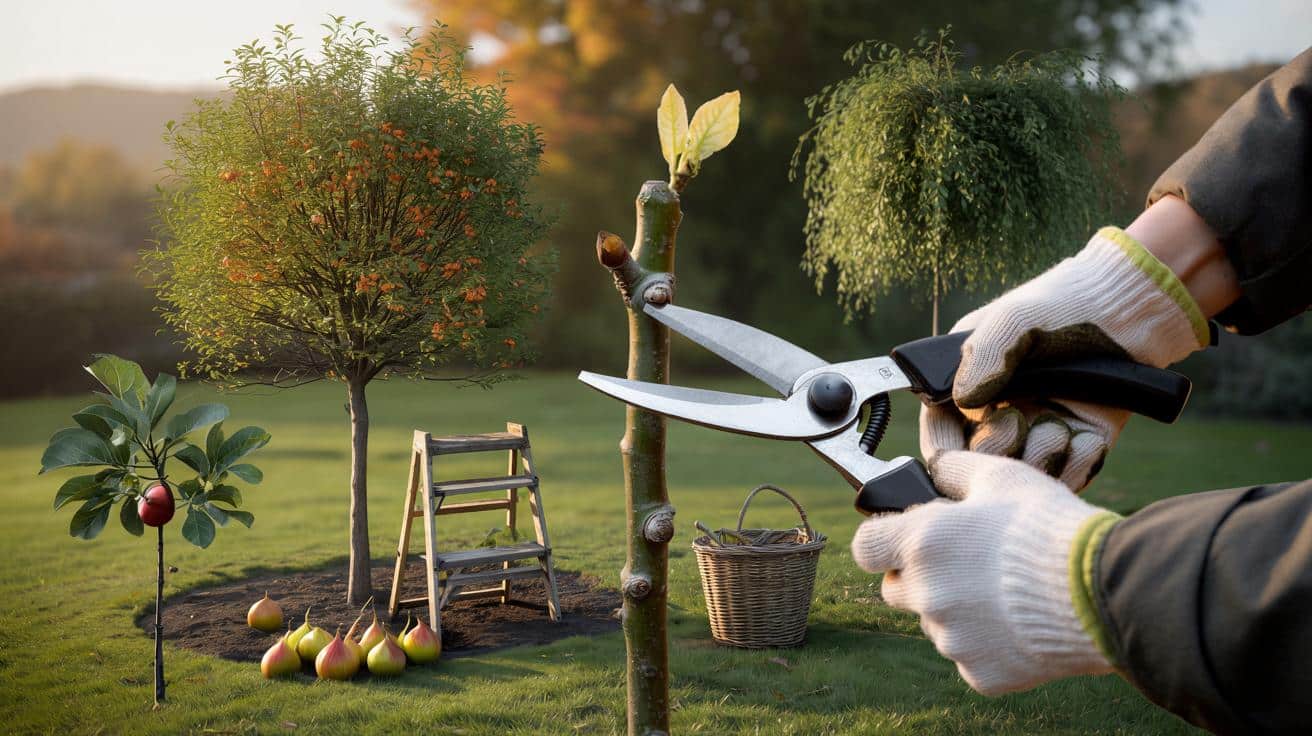Fruit trees sag after a generous year, and ornamental canopies thicken just as the wind picks up. The window to act is brief, right there between the last warm afternoon and the first hard frost. Miss it, and winter does the pruning for you, messily.
It was one of those mild Saturday mornings when the air tastes like apples. A neighbour held a ladder while I snipped back a stubborn watershoot, the garden humming with dry leaves and distant traffic. Magpies rummaged under the hedges, and every cut felt like a small decision about next year’s shape and safety. Then I saw the rot.
Five trees that quietly ask for an autumn trim
Apple trees look relieved after harvest, like athletes slipping off their kit. Their structure is easy to read once the leaves begin to loosen, which makes autumn a sweet spot for a calm, corrective tidy. Crossing branches that polished each other in summer suddenly look obvious, and tall whips skyward invite a snip that redirects energy back into fruiting spurs.
On our street, Joe’s old Bramley spent August throwing fruit at the pavement. Come late September, he took down the worst of the tangles and thinned crowded spurs by a third. The following year, the apples were bigger, and the branch that used to scrape the car roof never touched it again. One careful afternoon rewritten his next harvest.
Why does this timing help? As sap slows and leaves drop, cuts tend to dry neatly, and the tree isn’t wasting energy on new soft growth. You can see the scaffold, remove dead wood without guesswork, and cut away storm-prone limbs before they become an emergency. There’s a rhythm to it: apple and pear after picking, fig once its big, hopeless fruits are off, rowan when the berries have gone, willow before winter gusts start testing your fence.
What to cut, where to cut: apple, pear, fig, rowan, willow
Apple: take out dead, diseased or damaged wood first, then any branch that rubs another. Shorten vigorous upright watershoots by two-thirds, leaving a couple of buds to develop into fruiting laterals. On crowded spurs, thin gently so there’s breathing space, and keep cuts just above outward-facing buds to open the shape.
Pear: similar dance, but pears love vertical growth. Tip back tall leaders lightly and favour horizontal laterals that carry fruit. Remove tight crotch angles that invite splits, and keep the centre airy to reduce scab and canker pressure. Rowan: after birds have stripped the clusters, lift the crown a touch by removing low, awkward branches and any inward-growing twiggy clutter.
Fig: take out long, sappy extension growth, counting four to five leaves from the base of each new shoot. Remove any figs larger than a marble that won’t ripen now, and leave the tiny pea-sized fruitlets; they’re next year’s promise. Willow: clear out storm-suspect limbs and epicormic shoots sprouting at the base, making clean cuts just outside the branch collar for quick sealing. We’ve all had that moment when a windy night turns a small flaw into a big problem.
Practical rhythm, common missteps, and a quick cut list
Work in loops: step back, look, cut, step back again. Clean blades with a dab of methylated spirits between trees, and keep cuts slanted to shed water. Go slow near the main scaffold; small cuts move shape more than people think. *I breathed out, slowly.*
Big mistake number one: topping trees. It triggers wild regrowth and weak attachments. Number two: over-pruning in one hit. Keep to roughly a fifth of the canopy on mature trees, less on stressed or young ones. Number three: cutting in rain, which spreads spores. Let’s be honest: nobody does this every week, so it helps to plan one dry afternoon and stick to the basics.
There’s a kind of quiet confidence that follows simple, clean cuts.
“Prune with a purpose, not a habit,” said an old orchardist who taught me to count buds with my thumb. “Every cut should buy you light, air or safety.”
- Apple: thin crowded spurs, shorten watershoots, remove rubbers.
- Pear: favour horizontals, open the centre, reduce steep forks.
- Fig: cut back new whips to 4–5 leaves; remove overgrown figlets.
- Rowan: lift the crown a notch, clear inward clutter, keep it graceful.
- Willow: take off risky limbs and basal shoots; leave clean collars.
What an autumn prune sets in motion
You’re not just tidying; you’re shaping next year’s stories. Apples and pears put their best fruit on well-lit laterals, and a little restraint now turns spring blossom into something generous rather than crowded. Figs reward decisive cuts with fewer, better shoots and a cleaner framework that winches scorchy summers and drizzly autumns into balance.
Rowan stops snagging the path, keeps its limbs honest, and throws shade where you actually want it. Willow, forever enthusiastic, learns its boundaries without sulking. And your winter? Quieter. Less ladder-in-a-storm energy, more long mug-of-tea watching the garden hold its shape. The small habit of autumn pruning becomes a kind of seasonal punctuation. Not an ending. A comma that lets next year breathe.
| Point clé | Détail | Intérêt pour le lecteur |
|---|---|---|
| Prune after harvest and leaf-fall | Apple, pear and rowan cuts seal neatly as sap slows | Cleaner wounds, clearer structure, easier decisions |
| Light, purposeful cuts | Remove dead/diseased first, then rubbing, then shape | Fewer problems, more fruit, safer canopies |
| Species-specific touches | Fig: keep pea-sized fruitlets; Willow: preserve branch collars | Better outcomes with less effort and guesswork |
FAQ :
- Is autumn really okay for apples and pears?Yes for a light, post-harvest tidy and structural tweaks. Save heavy renovation for mid to late winter when fully dormant.
- Should I prune cherries or plums now?No. Stone fruits are best pruned in summer after fruiting to dodge silver leaf disease and slow-healing winter wounds.
- How much can I remove in one go?On a mature, healthy tree, about 20% of the canopy. On young or stressed trees, keep it gentler and spread work across seasons.
- What about disinfecting tools?Wipe blades between trees, especially after canker or dieback, to reduce the chance of carrying problems to fresh cuts.
- Can I pollard willow in autumn?If it’s an established pollard head, a light autumn tidy is fine. Leave heavy cut-backs for mid-winter when growth is quiet.










Love the timing breakdown—never knew to leave pea-sized figlets for next year. Planning a light tidy on apple and rowan this weekend, then saving heavier cuts for dormancy. My ladder and I thank you 🙂